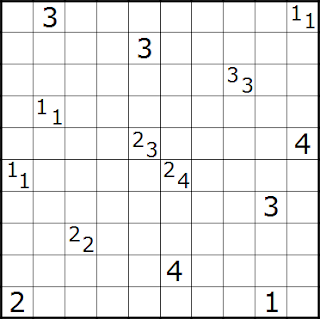Some examples of these new variants can be found online.
Tapa LITS:
Grandmaster Puzzles
A Cleverly Titled Logic Puzzle Blog (Streampunk/Tetra Firma)
Different Tapa:
Maybe Puzzles
This post will also contain some examples of the known variants that have featured on this blog below.
Rules for Tapa
1. Tapa With Borders.
Follow standard Tapa rules. Additionally, there is a 6x6 puzzle hidden in this 10x10 grid. Locate the puzzle and solve the remaining grid.
 |
| Click to enlarge |
2. Tapa-Like Loop
In this Tapa the wall is formed by a single continuous loop. Clues inside the grid represent the number of neighbouring cells visited by the loop. If there is more than one number in a cell, each number should represent a separate section of the loop. In this puzzle, the no 2x2 rule of Tapa does not apply.
 |
| Click to enlarge |
Follow standard Tapa rules. Additionally the white cells and black cells form two congruent shapes. Clue cells count a white cells. The shapes may be rotated or reflected.

For Dissected Tapa, why do the directions *always* say "the shapes may be rotated or reflected"? As far as I can tell, the only time a valid tapa either uses reflection or doesn't need rotation is when one dimension of the grid is 1 or 2. Am I missing something?
ReplyDeleteIt's because these variant rules are literally taken from Dissection puzzles. In Dissection puzzles making this distinction is more relevant.
Delete